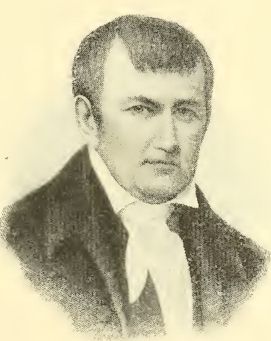First White Settlers
Because of glowing accounts given by the
hunters on their return from the French Lick country a number of
colonists in East Tennessee, North Carolina and Virginia decided
to move thither and form a settlement. At a council of those
interested, held at Watauga, it was decided that a company of
men should first go over, clear land and raise a crop of corn,
that their wives and children might have bread awaiting them
when the removal should take place later on.
For this purpose a party set out from Watauga in the month of
February, 1779. This band of hardy pioneers consisted of James
Robertson, George Freeland, William Neely, Edward Swanson, James
Hanly, Mark Robertson, Zachariah White, William Overall, and a
Negro man whose name is unknown. James Robertson, the leader,
had carefully selected his men, taking with him only suitable
volunteers and experienced woodmen, all true and tried. After
three weeks of hardships on their journey over the mountains and
through the wilderness they reached the French Lick. A few days
later they were joined by a small company from the region of New
River, Virginia. These were led by Kasper Mansker, with whom
Robertson had doubtless been in correspondence before leaving
Watauga. A body of land near the Sulphur Spring and now within
the corporate limits of Nashville was selected as the site of
the cornfield. This both parties united in clearing, planting
and cultivating during the spring and summer which followed.
Around it they built a rude fence for its protection against the
wild animals that came daily to drink at the spring.

Brigadier-General James Robertson "Father of Tennessee''
When at length the crop was laid by,
Swanson, White and Overall were left to keep the buffalo out of
the corn while the rest of the party returned to the settlement
for their families. James Robertson, however, did not go with
the latter, but made the journey homeward by way of Kaskaskia,
Illinois. This pilgrimage was for the purpose of having an
interview with General George Rogers Clark, a distinguished
citizen and soldier of Virginia, and pioneer in the settlement
of Kentucky. The latter had founded the city of Louisville at
the Falls of the Ohio in 1778, and was now quartered near
Kaskaskia at the French fort he had recently captured.
As previously related, the boundary line between North Carolina
and Virginia, to which the territory included in Tennessee and
Kentucky at this time respectively belonged, had not yet been
fixed. Robertson believed that the country around French Lick
was within the limits of Virginia. He also doubted the legality
of the title thereto of Henderson's Transylvania Company under
whose patronage he and his fellow settlers had come. He had
heard that General Clark, as the agent of Virginia, had for sale
along the Cumberland certain land claims, called ''cabin
rights," which could be bought for a small sum. By the purchase
of these he might insure himself and his fellow immigrants
against future annoyance.
Just what information Robertson received during his visit is
unknown to history. It is believed, however, that General Clark
gave him assurance that French Lick was safely within the
boundary of North Carolina, and that he would therefore need no
favors from Virginia. At least that was the impression that soon
thereafter prevailed among the colonists. Before leaving
Kaskaskia, Robertson bought a drove of livestock, consisting of
horses, mules and ponies. Finding some men who were going to
East Tennessee, he offered them passage on the backs of his
animals. The proposition was readily accepted, and soon this
caravan was on its way to Watauga, the route being to
Harrodsburg, Ky., and thence through Cumberland Gap. On reaching
home Robertson found everything in readiness for an early
removal to the new settlement.
By the middle of October a company of about 380 immigrants,
gathered from all the settlements between Knoxville and New
River, were ready to begin the journey.
It was arranged that they should go in two parties. The first of
these, led by James Robertson, and consisting of a majority of
the men, should travel overland, and by an early arrival have
everything in readiness for the coming of the second party. The
latter, composed largely of the families of the first party, and
commanded by Colonel John Donelson and Capt. John Blackmore,
were to proceed by boats down the Tennessee River to the Ohio
and thence up the Cumberland to French Lick.
It was agreed that after the arrival of the land party at the
new settlement some of their number should go down to the upper
end of Muscle Shoals on the Tennessee River in North Alabama.
There they would either await the coming of the voyagers under
Donelson and Blackmore, or leave certain signs indicating
whether or not it was considered safe for the river party to
quit the boats and go from thence across the country to the
French Lick. If this could be done, it would shorten the journey
and also avoid the danger of running the shoals.
Colonel John Donelson, who is mentioned in connection with the
above, was born in the year 1718, and was a native of
Pittsylvania County, Virginia. He was by profession a surveyor,
which vocation in that day was a mark of the highest educational
attainment. From the same section of Virginia originally came
the Robertsons, the Bledsoes, the Cartwrights and Hendersons,
all of whom were untiring in their efforts to extend the limits
of civilization across the western mountains. We shall learn
much more of Colonel Donelson in subsequent chapters.
Early History of Middle Tennessee

Early History of Middle Tennessee, BY
Edward Albright, Copyright, 1908, Brandon Printing Company,
Nashville, Tennessee, 1909

|



